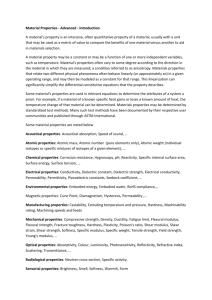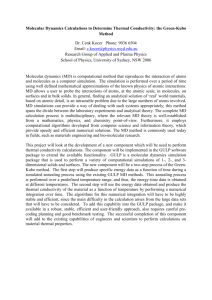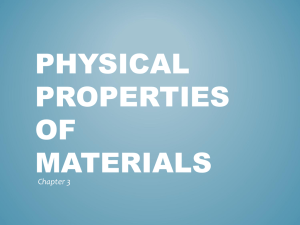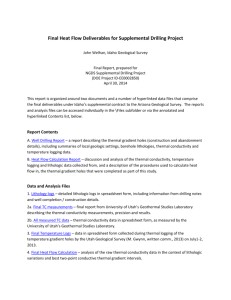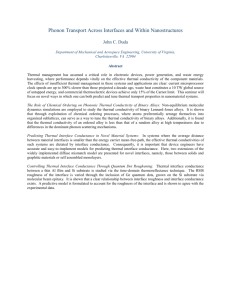Thermal Conductivity Lab: Liquid & Gas Experiment
advertisement
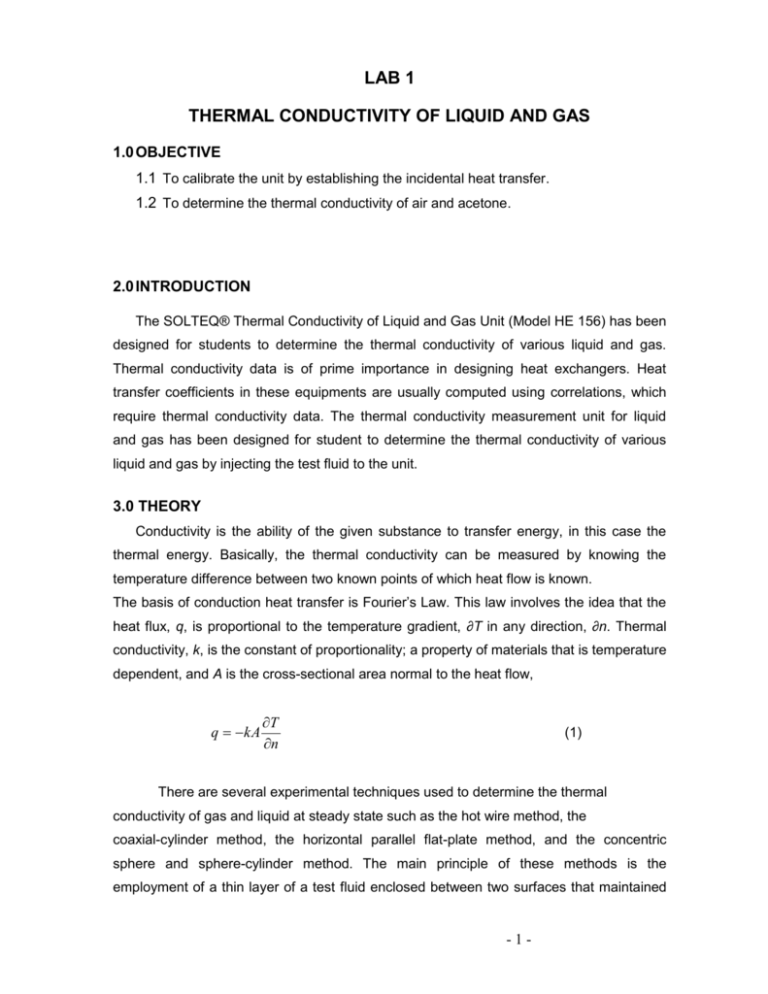
LAB 1 THERMAL CONDUCTIVITY OF LIQUID AND GAS 1.0 OBJECTIVE 1.1 To calibrate the unit by establishing the incidental heat transfer. 1.2 To determine the thermal conductivity of air and acetone. 2.0 INTRODUCTION The SOLTEQ® Thermal Conductivity of Liquid and Gas Unit (Model HE 156) has been designed for students to determine the thermal conductivity of various liquid and gas. Thermal conductivity data is of prime importance in designing heat exchangers. Heat transfer coefficients in these equipments are usually computed using correlations, which require thermal conductivity data. The thermal conductivity measurement unit for liquid and gas has been designed for student to determine the thermal conductivity of various liquid and gas by injecting the test fluid to the unit. 3.0 THEORY Conductivity is the ability of the given substance to transfer energy, in this case the thermal energy. Basically, the thermal conductivity can be measured by knowing the temperature difference between two known points of which heat flow is known. The basis of conduction heat transfer is Fourier’s Law. This law involves the idea that the heat flux, q, is proportional to the temperature gradient, ∂T in any direction, ∂n. Thermal conductivity, k, is the constant of proportionality; a property of materials that is temperature dependent, and A is the cross-sectional area normal to the heat flow, q kA T n (1) There are several experimental techniques used to determine the thermal conductivity of gas and liquid at steady state such as the hot wire method, the coaxial-cylinder method, the horizontal parallel flat-plate method, and the concentric sphere and sphere-cylinder method. The main principle of these methods is the employment of a thin layer of a test fluid enclosed between two surfaces that maintained -1- at different temperatures. The apparatus is consists of two coaxial cylinders vertically placed and leaving a very small annular gap that is charged with the test fluid. The inner cylinder is heated with the electrical heater. As the thermal low across the gap is fairly radial, the governing equation is the Fourier equation, which relates heat output, Q, the inner cylinder temperature,T1, and outer cylinder temperature, T2 with the thermal conductivity, k, of test fluid : R ln 2 R1 Q k T1 T2 2L (2) where R1 and R2 are radius of the annulus, filled with the gas (R2> R1), and L is the length of cylinder. Figure 1: Heat conduction in coaxial cylinders method From the explanation, to find the thermal conductivity coefficient we must use Fourier’s Law as stated in equation (1). Solving for k we get, k qc dx A dT (3) -2- For radial heat conduction in a cylinder, dx become dr , and area A , is the cross sectional area of a conducting path. At the steady state conditions across the small radial gap, dr become Δr, dT become ΔT and we get, k qc r A T (4) In order to find the heat by conduction (qc) we can use the conservation of energy equation. When we applied it to this system we will get, qc q gen qlost Q qlost (5) By substituting equation (4) into equation (5), we get the following expression for qlost T qlost q gen q c Q kA r (6) We may assume qlost to be proportional to the temperature difference between the plug and the jacket. This assumption will be tested with a linear regression analysis, and estimate qlost from the calibration graph of incidental heat transfer versus the plug and jacket temperature difference. This analysis used the known thermal conductivity of air, kair. The thermal conductivity coefficient can then be calculated for other fluids by the temperature difference across the fluid. -3- 4.0 MATERIALS AND EQUIPMENTS 4.1 Thermal conductivity of liquid and gas unit Figure 2: Thermal Conductivity for Liquid and Gas Unit 1. Thermocouple Sensors 5. Cooling water intlet 2. Sample Port (Top) 6. Heater 3. Cooling water Control Valve 7. Sample Port (Bottom) 4. Cooling water outlet Figure 4 Figure 3: Construction of Thermal Conductivity of Liquid and Gas Unit -4- 5.0 PROCEDURES 5.1 Experiment 1: Calibration of the thermal conductivity study unit 5.2.1 Use air as the sample for the calibration. 5.2 Experiment 2: Determination of thermal conductivity of liquids and gases. 5.2.1 Use air as the sample of the experiment. 5.2.2 The power regulator to about 25 watt. 5.2.3 Record the power and temperature readings (T1 to T2) 5.2.4 Repeat the experiment by substituting the air with acetone with the heating power of 100 watt. 6.0 RESULTS AND CALCULATIONS 6.1 Plot a calibration graph of incidental heat loss, qlost versus temperature difference (Data of Experiment 1). Make sure to draw the straight line at zero intercept. 6.2 Use slope of the graph to calculate qlost in Experiment 1 for both air and acetone: 6.3 Calculate thermal conductivity of air and acetone and compare the value with the theoretical. 7.0 QUESTIONS 7.1 Explain why the gap between the two cylinders is small? 8.0 CONCLUSION 8.1 Based on the experimental procedure done and the results taken draw some conclusions to this experiment. -5-


